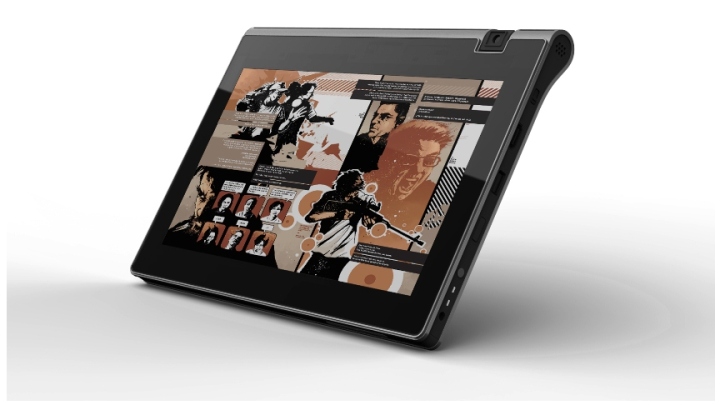The bezel of the tablet has been slightly enlarged (as can be seen on the picture):

There will be four base variants of the Adam:
- PixelQi screen, wi-fi
- PixelQi screen, wi-fi, 3G cellular modem
- Ordinary LCD screen, wi-fi
- Ordinary LCD screen, wi-fi, 3G cellular modem
Both the PixelQi and the ordinary LCD screen will have capacitive, multi-touch interface and 1024x600 resolution, anti-glare coating (matte finish). This is especially useful for reading and outdoor use. PixelQi variant is usable in direct, strong sunlight.
There is no info yet on the HSDPA/HSUPA speeds for the 3G cellular modem.
For internal storage, 16 and 32 GB flash will be selectable.
Common specification elements:
- Nvidia Tegra2 System On Chip operating at 1Ghz (dual-core ARM Cortex-A9)
- 1 GB of RAM (DDR2, 667Mhz)
- WLAN 802.11 b/g/n (previously it was not known whether it will have "n" as well)
- Bluetooth 2.1 EDR with A2DP (for stereo bluetooth headsets)
- External loudspeakers (expected to be good quality for enjoyable video playback), external microphone, headphone and microphone jack
- 3.2 Mpixel swivel camera which will be usable for both taking photos and video calls
- 2 normal size USB ports and 1 mini-USB port
- HDMI output
- microSD card slot
- Docking port
- 3-axis accelerometer
- Ambient light sensor and automatic screen backlight adjustment (this will have a big, positive impact on the battery runtime)
- Manual LCD back-light switch (most useful for the PixelQi variant)
- Standalone GPS chip and antennea (with support for A-GPS quick positioning). The Adam will be capable for navigation without 3G network coverage
- Sound volume keys
- Backside trackpad (this is an interesting part, check the videos on Youtube)
- 24 Wh battery (3-cell configuration). Expected runtime is 15 hours for wifi browsing (recently reported on the blog), 140 hours of listening to audio, more than a week standby
- Operating system is Android Froyo (2.2) with a custom, tablet-enhanced user interface
It is not yet known whether the Adam will have a digital compass (for better navigation and augmented reality apps). It has been asked on the Notion Ink blog comments but no confirmation yet. It would be very much logical to have it in a machine with this hardware level but the long-time omission from the specs indicates otherwise.
Target end-user prices are between $400 and $500 for the 4 variants in the US. Their target is to keep even the fully loaded variant below the price of the entry level iPad.
Availability/release of the Adam is not finalized, but the Early Access Program winners (developers) are expected to have their machines shipped around November 15. Public release should happen soon after in order to make the Adam available for the Christmas shopping season.
Sources:
DDR2